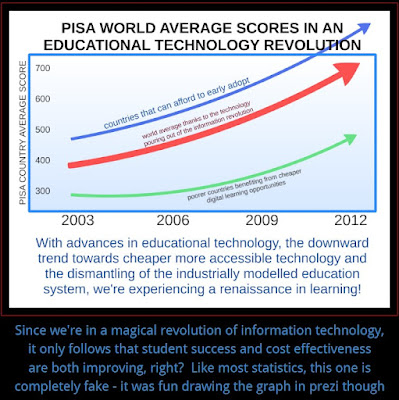Back in 2014 I had one of those strange moments when I suddenly found myself freed from the day to day necessities of the classroom and thrust into a space where I had time to think about pedagogy. I once had an administrator tell me, “what does pedagogy even mean anyway? It’s one of those words that doesn’t mean anything.” I’ve never felt that way but perhaps that’s because I’ve focused my career on teaching rather than getting out of the classroom at the earliest opportunity. Throughout that career I’ve clung to moments of pedagogical best-practice in a sea of compromises.
The main purpose of schools is to run a schedule that has students in set places at set times to the benefit of adults. You can call it daycare if you want to, many people treat it like one. Order and regularity are the primary functions of school organization, not learning; hence that astonishing observation from someone who is focused on managing it. Being a teacher committed to teaching has often put me at odds with this reality.
I hesitated to get into education for a long time because I found it a dehumanizing experience as a student.
 |
| This is the expectation people have around technology integration – it’s supposed to improve learning! But scores continue declining. |
Over the Easter long weekend in 2014 I was invited down to the ASU/GSV Summit in Phoenix. Stepping out of the moribund but relatively well funded Canadian education system into the ‘breaking bad’ of America where teachers live just above the poverty line and everyone is fixated on common curriculum success dictated by standardized testing (you don’t get to be the 25th best education system in the world by chasing pedagogy!), I wasn’t sure what to expect, but there were a lot critical thinkers at this summit.
One that really rocked me was Brandon Busteed who stated (to the astonishment of everyone present) that, ““Educational technology has failed to move the needle on either cost effectiveness or student success in the past ten years.” He then showed statistically significant drops in literacy and numeracy even as the buzz around educational technology as an answer to everything was at a fever pitch. You’d think we’d have come around to a sensible integration of digital technology in learning nearly a decade later, but post pandemic things are even worse.
 |
| PISA Results from that time show statistically significant drops in learning. Things haven’t improved even with accelerated technology use. On top of that, COVID proved that we were unable to leverage ICT even during an emergency to preserve essential learning. |
Post COVID we’re in a recovery situation because we couldn’t leverage technology to work through pandemic lockdowns. We had the tools but most people in education (children and adults) have no idea how to use technology to actually improve (or even provide basic) learning opportunities. On the back of forced rapid technology integration due to the pandemic, our learning outcomes have gotten even worse. Our information revolution has made data so much easier to access and manipulate, but not in education where we used digital to imitate the paper based systems we clung to long after the rest of the world had moved on.
***
Looking back over a teaching career spent in the middle of an ‘education technology revolution’, I’ve been frustrated at how technology has been applied in the classroom. Coming out of information technology into education in 2004, I found that classrooms were a decade or more behind the businesses I’d just been supporting. I was even more surprised to see schools going out of their way not to engage with digital learning opportunities – banning them for the longest time before reluctantly adopting them with no training or education (for staff or students) around their use. This delay resulted in educators being LESS digitally literate than the students they serve. As a result, digitally delayed teachers weren’t thinking about how edtech could enhance pedagogy because they were some of the least capable of doing so. Delaying digital integration has damaged both staff and students.
We’ve fumbled one of the greatest opportunities to improve education in the past century and have integrated technology so poorly that it actually reduces student success rather than amplifying it. We turned generic, paper handouts into generic, online documents, ignoring opportunities for collaboration and individualization that fluid digital information systems offer.
That rush to imitate paper based education on screen resulted in a drop in photocopying budgets which thrilled administration, but what we lost in printing costs we more than made up for in having to buy screens for everyone (something we still struggle with). Neither way is particularly environmental, but the screen route produces more waste and uses far more energy while reducing learning outcomes in digitally illiterate classrooms where students taught on home entertainment systems can only see digital devices as toys. This shell game of showing small cost reductions moving away from paper while ignoring the massive costs of edtech has further diminished our ability to focus on pedagogical best practices. Less money in the system is less money in the system.
We’re facing a generational digital skills shortage that highlights our failure to engage with digital literacy in a meaningful way. Teachers are less digitally literate than the general public because they’ve been working in this moribund system determined to ignore the benefits of digitally enhanced pedagogy. We have digitally oblivious teachers depending on students who have been told that they are digital natives and don’t need to learn how technology works because they can turn on an X-Box. You don’t need to look hard to understand why education makes such a juicy target for cyber-criminals. When I reach out in my current capacity as a cyber-focused educator I’m told by ministries of education across the country that online safety is covered in health class. Yes, you heard that right, phys-ed teachers are covering cybersecurity training for our students (or more likely skipping it).
You’re seeing this reflex again now with the panic around artificial intelligence inspired by ChatGPT. Students are using it to demonstrate the learning they didn’t do and teachers are using it to auto-generate the tedious and generic necessities required to keep the education system doing what it has always done. If we play our cards right no one (students or teachers) will actually be involved in education by 2030.
| What we’re heading towards if we continue to ignore digital pedagogy! This was made with the Dall-E 2 AI image generator! |
***
How would this educational technology revolution that never happened have gone down in a better world? We would have started integrating digital technologies as they emerged and teaching cross curricular digital media literacy as soon as we began using the technology. Rather than offloading digital fluency to home life and creating a skills gap that widens inequity, we would have taken responsibility for the technology as we adopted it.
As digital media literacy improved, teachers wouldn’t be behind the rest of society in terms of technical fluency and would have worked towards developing digitally empowered pedagogy that uses the benefits of easily accessible and malleable information to create a radically individualized approach to learning that produced truly equitable learning outcomes for all. This targeted approach to learning also streamlines the industrial education system into a more efficient and agile format.As cloud based technology emerged, these digitally fluent teachers engage data science to produce deep understandings of each student’s learning journey. These personalized data clouds are leveraged to produce bespoke learning outcomes. Instead of using digital technology to imitate class based, low-resolution lessons from the age of paper, we leverage our ICT revolution to take advantage of the fluidity of digital information. As we move away from the old, low resolution model we start to see astonishing efficiencies in student learning.
Our schools have evolved in the past two decades from age-based 19th Century storage units to smaller, agile, digitally empowered community learning centres where students work towards their own learning mastery. This individualized learning environment empowers students to take control of their own educational journey. School is no longer something being done to them but something they discover about themselves.
That education system resiliently leveraged digital empowered pedagogy to individualize and empower students across all interests and subjects. During the pandemic this education system leveraged its digital expertise to connect students, reduce social anxiety and keep learning alive by using our networked world effectively rather than treating our illiteracy in it as an excuse to quit.
Rather than being an easy target for cybercriminals, education is fortress of cyber-fluency where staff and students demonstrate exemplary digital awareness and integration. Instead of being the most likely to click on a phishing email, teachers are the least likely to infect their own networks. Schools are community centres of digital excellence that support their community families and local businesses in terms of technology support.
This better education system is agile and responsive, offering learning opportunities and variations in support for every student based on a detailed understanding of their needs. As a result, resources are applied in targeted, financially effective ways Low resolution reporting processes like report cards are a quaint memory. Learning reaches demonstrated thresholds of understanding leading students to graduate through curriculums at their own pace. Parents can access this data in real time and are partners in their child’s learning rather than arms-length critics. Some students would graduate in their early teens, others later, but everyone would graduate with mastery knowledge of the fundamentals including the digital fluency needed to succeed in the world beyond school.
***
To summarize:
- Education delayed engaging with digital technology for as long as it possibly could, putting it and everyone in it at a distinct disadvantage in the modern world. This frustrates parents and anyone else outside of education systems to no end.
- The delay in digital engagement has resulted in entire generations of teachers and students who are less digitally literate than the general population.
- When digital adoption finally took hold education used it to replicate the same lack of individualization that characterized the paper based learning that proceeded it.
- Technology integration in the classroom depends on digital familiarity at home because many teachers were less digitally familiar than the general population and most schools still struggle to provide equitable access to hardware.
- The digital divide has grown because of this ‘leave it to the parents’ approach because some simply can’t provide this essential media literacy.
- Classroom management headaches due to students misunderstanding that digital technology is a tool and not a toy are the direct result of this approach.










